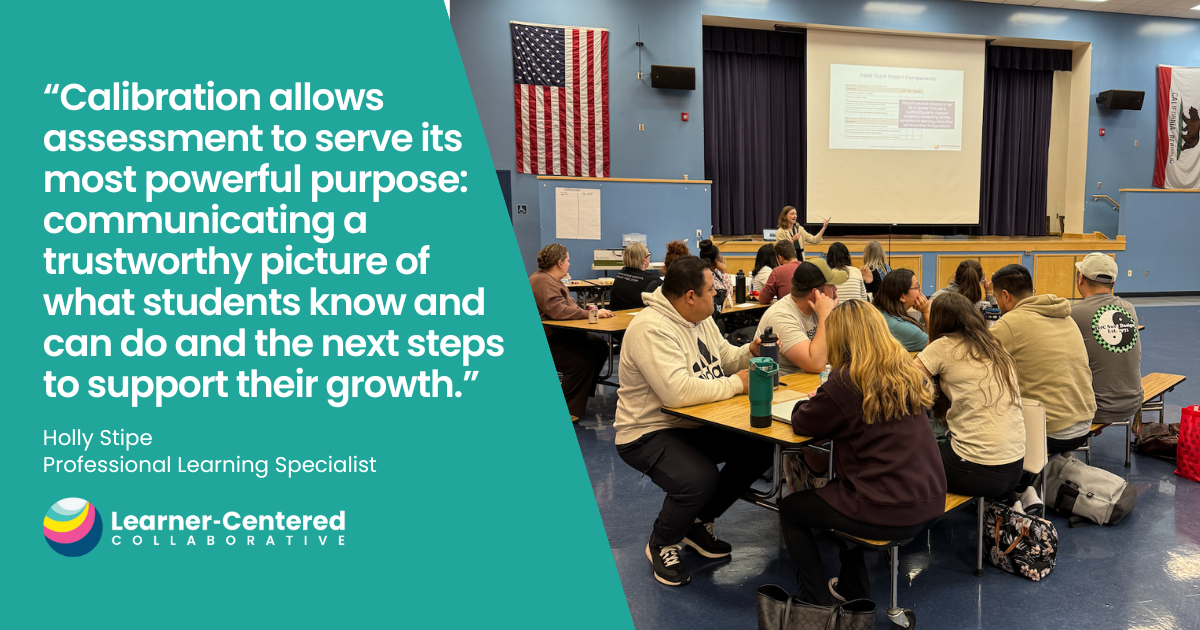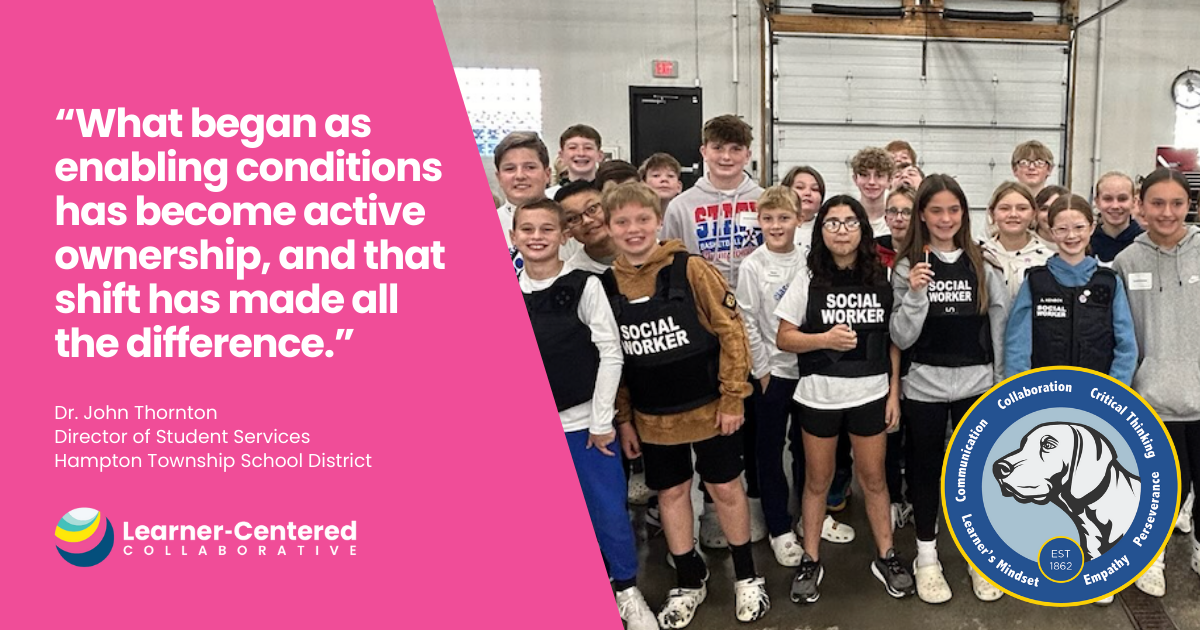All Goals Are Not Created Equal
Guest blog post by Erik Burmeister
Erik Burmeister is the Founder and Principal of Solutionary Advisors, a member of the Learner-Centered Collaborative Advisory Council, and the former Superintendent of Menlo Park City School District in California.
Take any course. Ask any expert. Read any book. When it comes to curating a portrait of leadership, the importance of goal setting is central to the narrative. In education, we write goals on our school site plans, add goals to our evaluations, develop goals for our strategic plans, and require goals from our students.
If goals are so transformational, why aren’t we realizing more of the results we want to see? If we don’t accomplish our goals, is it an abject failure or is there incremental benefit from the attention to outcomes? Are goals as essential as we think they are?
Having served at all different levels of education from teacher to superintendent and now as an advisor to educational leaders across the country, my opinion of goals could best be described as “neutral.”
It’s not that I don’t see the power of goals and goal-setting. I absolutely do. It’s not that I haven’t experienced my fair share of success with reaching goals; quite the contrary. I have seen goals galvanize a team and outcomes exceed expectations. It’s not even that I don’t encourage the principals and superintendents that I coach to set, communicate, and achieve goals. I do that regularly.
My neutrality is not in the value of goals. Whatever indifference I experience comes from years of seeing goal setting be the beginning AND the end of the conversation. Educators nearly always have the right intentions. They want to set lofty goals and work hard to achieve them. Due to the reality of the demands, though, goal-setting becomes a box we check, rather than the beginning of an important journey involving planning, execution, reflection, and iteration.
In the spirit of wanting goals to be an invaluable part of any leadership endeavor, I want to shine a spotlight on the conditions and actions necessary that I have seen allow goals to provide their greatest potential.
Don’t set goals for the sake of setting goals (unless you have to).
In many educational contexts, and especially at the district level given compliance requirements, goals can quickly and easily feel formulaic and contrived. The assumption with a goal is that there will be a static evaluation of whether or not you accomplished the goal. When you can, avoid engaging in processes that don’t add value and don’t feel genuine. When leading a group of individuals, it might be more advantageous to set intentions for your work or draft some success criteria around the tasks the team needs to accomplish. In education, when you are required to set formal goals, there isn’t a point in fighting it even if you don’t feel it is necessary or worthwhile. In education, as in life, we have to pick our battles. AND…
Be honest about the role of the goals (at least with yourself).
When required to set goals–even and especially when you don’t think doing so will be particularly helpful or successful–be honest with yourself and those you lead about how much time, energy, and mindshare individuals should devote to specific sets of goals. Educators understand all too well the high level of compliance documentation involved in receiving even the most menial local, state, and national funding. Goal setting to satisfy heavily bureaucratic processes is, unfortunately, part of doing business. With the sheer number of goals required to produce in a year, it can’t be true that all goals are important. If everything is important then nothing is important. The science of leadership is knowing how to write goals and doing so well and on time. The art of leadership is knowing what value to place on all the different goals we set.
In schools, goals that focus on learners are most valuable.
Schools are first and foremost learning organizations. Yes, schools provide health/safety services, transportation, food, community development, facilities, etc. Our core work, our purpose for being, however, is learning and our core customer is the learner. If it is true that we are awash in too many goals in schools and too many goals diminish the value of them all, then those goals that focus on the primary focus of our work–learning and learners–should have priority. One easy analysis of the effectiveness of your goals is to separate all the goals you have that are learner-centered from all those that are not. Elevating learner-centric goals or eliminating goals that have nothing to do with learning can be effective at creating clarity and coherence for your organization. When writing goals, consider how the attainment of each goal will impact learners.
Don’t set goals where vision should reside.
It’s not uncommon for educational leaders to confuse goals for vision. In my experience, goals work best when they serve a larger, aspirational, org-wide vision developed over time with the meaningful input of a community’s stakeholders. Goals that don’t serve a vision are isolated. They exist in a vacuum. Efforts aren’t contextualized to serve a greater purpose. Without a clear purpose, the individuals entrusted to meet goals aren’t nearly as motivated or invested in the outcomes. If your organization is operating without a clear vision (and I don’t mean a strategic plan that gathers dust on a shelf), your time is probably best spent engaging your community in a meaningful design process to draft that vision, rather than setting a series of disconnected goals. The district I was so proud to have led for many years, drafted their Whole Child Learning and Development Framework (with the support of Learner-Centered Collaborative–shameless plug!). All the goals we set after the Framework’s implementation became much more meaningful and successful.
A must read if you’re wondering: What Is a Framework for the Future and Why Do You Need One?
Fewer is better.
Goals are most effective when there are fewer of them. Superintendents have five to seven bosses, depending on the size of the elected Boards that hire them. Each one of those members has their own perspective, priorities, and agenda. Very quickly the clarity and coherence of an organization’s purpose can be clouded by all the “interests” vying for priority attention. As a Superintendent, I regularly had to narrow the focus of our Board (and admittedly didn’t always do such a great job of it) to what was most important and what could realistically be accomplished in any given year. We were at our best when we had only a few goals that addressed the most pressing issues and promising opportunities.
Ready to get clear about your district’s vision for learners and the path forward to get there? Schedule a 30-minute consultation with our team to put together a plan customized for your learning community.
Chunk.
When it comes to goal-setting in schools and systems, the “it’s a marathon, not a sprint” adage is true. Rome wasn’t built in a day and neither was a high-functioning school or district. Pace yourself. It’s okay not to fix every problem in one year, especially not the first year. Chunking goals over a period of time allows teams to focus and fosters a work environment that doesn’t burn people out, ultimately allowing them to achieve the goals set forth.
Redefine accountability.
The degree to which teams avoid goals or hold them in low regard is highly correlated to their feelings about who will be held accountable for the results and how. Accountability confusion or fear is real. Leaders who find the most success with goal attainment AND team efficacy understand that team members need to know how they will be held accountable for the results. However, clarity isn’t enough. Teams that fear retribution, finger-pointing, lack of resources, etc. will ultimately falter. I have found the most effective approaches to accountability, not only achieve the desired results but are also supportive of the team because they include:
- Regular, collective data review that is depersonalized;
- Illustrations of success along the way;
- Celebration of those successes early and often;
- Empowerment of the team to identify opportunities for improvement;
- Honest, non-confrontational analysis and dialogue;
- Flexibility and a lot of listening;
- Opportunity to iterate over time; and,
- A culture of learning, rather than a culture of judgment.
Ultimately, whether goals sit on the figurative shelf gathering dust is up to us. The mere existence of a goal is simply an act of management. Creating the conditions for the successful action toward and achievement of our goals is an act of leadership.
Check out our self-paced leadership course on Establishing the Enabling Conditions for Learner-Centered Transformation.





